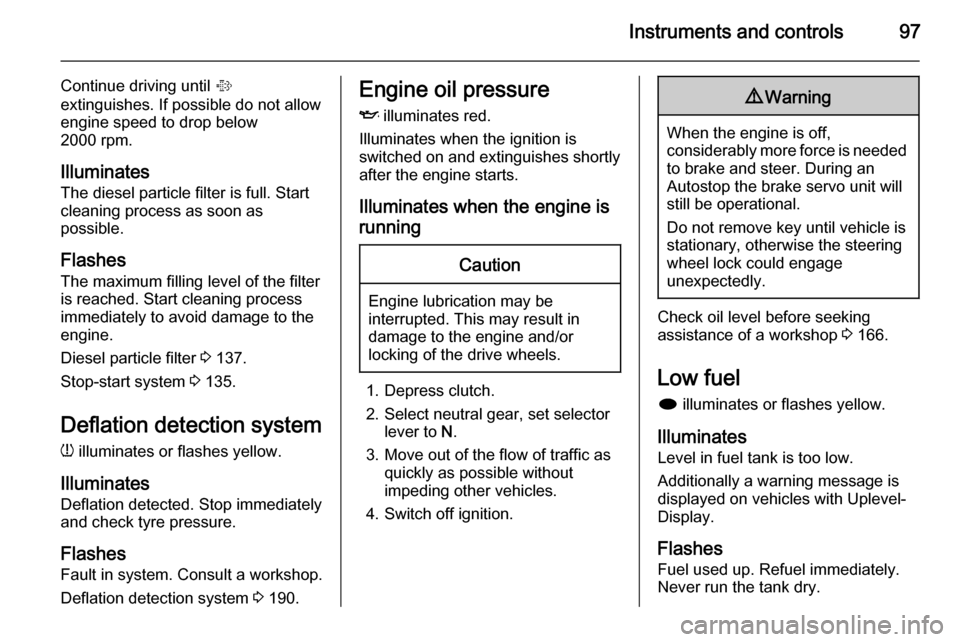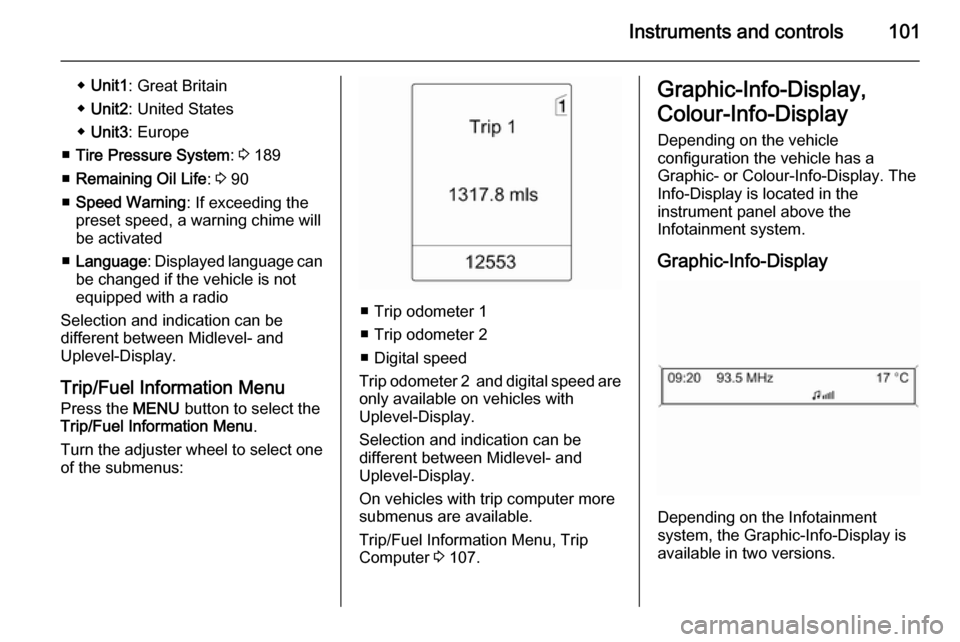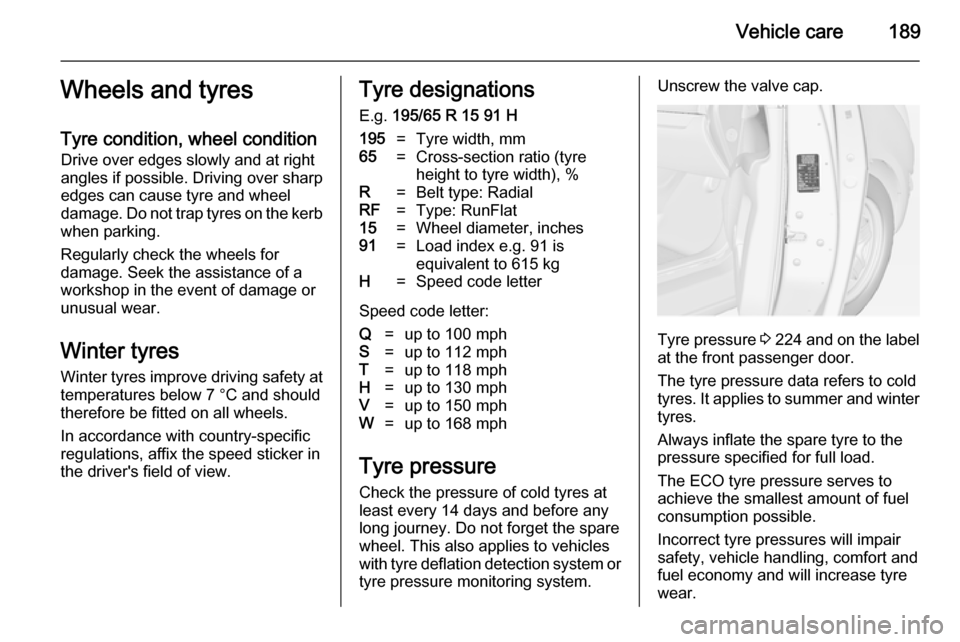fuel pressure VAUXHALL MERIVA 2014.5 Owner's Manual
[x] Cancel search | Manufacturer: VAUXHALL, Model Year: 2014.5, Model line: MERIVA, Model: VAUXHALL MERIVA 2014.5Pages: 237, PDF Size: 7.59 MB
Page 99 of 237

Instruments and controls97
Continue driving until %
extinguishes. If possible do not allow engine speed to drop below
2000 rpm.
Illuminates The diesel particle filter is full. Start
cleaning process as soon as
possible.
Flashes
The maximum filling level of the filter
is reached. Start cleaning process
immediately to avoid damage to the
engine.
Diesel particle filter 3 137.
Stop-start system 3 135.
Deflation detection system w illuminates or flashes yellow.
Illuminates
Deflation detected. Stop immediately and check tyre pressure.
Flashes Fault in system. Consult a workshop.
Deflation detection system 3 190.Engine oil pressure
I illuminates red.
Illuminates when the ignition is
switched on and extinguishes shortly
after the engine starts.
Illuminates when the engine is runningCaution
Engine lubrication may be
interrupted. This may result in
damage to the engine and/or
locking of the drive wheels.
1. Depress clutch.
2. Select neutral gear, set selector lever to N.
3. Move out of the flow of traffic as quickly as possible without
impeding other vehicles.
4. Switch off ignition.
9 Warning
When the engine is off,
considerably more force is needed
to brake and steer. During an
Autostop the brake servo unit will still be operational.
Do not remove key until vehicle is stationary, otherwise the steeringwheel lock could engage
unexpectedly.
Check oil level before seeking
assistance of a workshop 3 166.
Low fuel
i illuminates or flashes yellow.
Illuminates Level in fuel tank is too low.
Additionally a warning message is
displayed on vehicles with Uplevel-
Display.
Flashes
Fuel used up. Refuel immediately.
Never run the tank dry.
Page 103 of 237

Instruments and controls101
◆Unit1 : Great Britain
◆ Unit2 : United States
◆ Unit3 : Europe
■ Tire Pressure System : 3 189
■ Remaining Oil Life : 3 90
■ Speed Warning : If exceeding the
preset speed, a warning chime will
be activated
■ Language : Displayed language can
be changed if the vehicle is not
equipped with a radio
Selection and indication can be
different between Midlevel- and
Uplevel-Display.
Trip/Fuel Information Menu Press the MENU button to select the
Trip/Fuel Information Menu .
Turn the adjuster wheel to select one
of the submenus:
■ Trip odometer 1
■ Trip odometer 2
■ Digital speed
Trip odometer 2 and digital speed are
only available on vehicles with
Uplevel-Display.
Selection and indication can be
different between Midlevel- and
Uplevel-Display.
On vehicles with trip computer more
submenus are available.
Trip/Fuel Information Menu, Trip
Computer 3 107.
Graphic-Info-Display,
Colour-Info-Display Depending on the vehicle
configuration the vehicle has a
Graphic- or Colour-Info-Display. The
Info-Display is located in the
instrument panel above the
Infotainment system.
Graphic-Info-Display
Depending on the Infotainment
system, the Graphic-Info-Display is
available in two versions.
Page 155 of 237

Driving and operating153Caution
Use of fuel that does not comply toEN 228 or E DIN 51626-1 or
equivalent can lead to deposits or
engine damage and loss of
warranty.
Caution
Use of fuel with too low an octane
rating could lead to uncontrolled combustion and engine damage.
Fuel for diesel engines
Only use diesel fuel that complies
with EN 590.
In countries outside the European
Union use Euro-Diesel fuel with a
sulfur concentration below 50 ppm.
Caution
Use of fuel that does not comply to EN 590 or similar can lead to
engine powerloss, increased wear
or engine damage and may affect
your warranty.
Do not use marine diesel oils, heating
oils, Aquazole and similar diesel-
water emulsions. Diesel fuels must
not be diluted with fuels for petrol
engines.
Fuel for liquid gas
operation
Liquid gas is known as LPG
(Liquefied Petroleum Gas) or under
its French name GPL (Gaz de Pétrole Liquéfié). LPG is also known as
Autogas.
LPG consists mainly of propane and
butane. The octane rating is between
105 and 115, depending on the
butane proportion. LPG is stored
liquid at around 5 - 10 bar pressure.
The boiling point depends on the
pressure and mixing ratio. At ambient pressure, it is between -42 °C (pure
propane) and -0.5 °C (pure butane).Caution
The system works at an ambient
temperature of approx. -8 °C to
100 °C.
Full function of the LPG system can
only be guaranteed with liquid gas
which complies with the minimum
requirements of DIN EN 589.
Fuel selector
Page 161 of 237

Driving and operating159
Fuel consumption data and CO2
emission data are determined
according to regulation R (EC) No.
715/2007 (in the version respectively
applicable), taking into consideration
the vehicle weight in running order, as specified by the regulation.
The figures are provided only for the
purpose of comparison between
different vehicle variants and must not be taken as a guarantee for the
actual fuel consumption of a
particular vehicle. Additional
equipment may result in slightly
higher results than the stated
consumption and CO 2 figures.
Furthermore, fuel consumption is
dependent on personal driving style
as well as road and traffic conditions.Trailer hitch
General information
Only use towing equipment that has
been approved for your vehicle.
Entrust retrofitting of towing
equipment to a workshop. It may be
necessary to make changes that
affect the cooling system, heat
shields or other equipment.
Fitting of towing equipment could
cover the opening of the towing eye.
If this is the case use the coupling ball
bar for towing. Always keep the
coupling ball bar in the vehicle.
Driving characteristics and
towing tips Before attaching a trailer, lubricate
the coupling ball. However, do not do so if a stabiliser, which acts on the
coupling ball, is being used to reduce
snaking movements.
For trailers with low driving stability
and caravan trailers with a permitted
gross vehicle weight of more than1100 kg the use of a stabiliser is
strongly recommended when driving
above 50 mph.
If the trailer starts snaking, drive more slowly, do not attempt to correct the
steering and brake sharply if
necessary.
When driving downhill, drive in the
same gear as if driving uphill and
drive at a similar speed.
Adjust tyre pressure to the value
specified for full load 3 224.
Trailer towing Trailer loads9 Warning
Vehicles with engine A13DTE:
Use of towing equipment is
permissible for attaching
compatible bicycle carriers only.
Do not use towing equipment for
trailer towing.
Page 166 of 237

164Vehicle careVehicle careGeneral Information...................164
Vehicle checks ........................... 165
Bulb replacement .......................172
Electrical system ........................182
Vehicle tools .............................. 188
Wheels and tyres .......................189
Jump starting ............................. 200
Towing ....................................... 202
Appearance care .......................204General Information
Accessories and vehicle
modifications
We recommend the use of genuine parts and accessories and factory
approved parts specific for your
vehicle type. We cannot assess or
guarantee reliability of other products
- even if they have a regulatory or
otherwise granted approval.
Do not make any modifications to the electrical system, e.g. changes of
electronic control units (chip tuning).Caution
When transporting the vehicle on
a train or on a recovery vehicle, the
mud flaps might be damaged.
Vehicle storage
Storage for a long period of time
If the vehicle is to be stored for several months:
■ Wash and wax the vehicle.
■ Have the wax in the engine compartment and underbody
checked.
■ Clean and preserve the rubber seals.
■ Fill up fuel tank completely.
■ Change the engine oil.
■ Drain the washer fluid reservoir.
■ Check the coolant antifreeze and corrosion protection.
■ Adjust tyre pressure to the value specified for full load.
■ Park the vehicle in a dry, well ventilated place. Engage first orreverse gear or set selector lever to P . Prevent the vehicle from rolling.
■ Do not apply the parking brake.
Page 191 of 237

Vehicle care189Wheels and tyresTyre condition, wheel condition
Drive over edges slowly and at right
angles if possible. Driving over sharp
edges can cause tyre and wheel
damage. Do not trap tyres on the kerb
when parking.
Regularly check the wheels for
damage. Seek the assistance of a
workshop in the event of damage or
unusual wear.
Winter tyres Winter tyres improve driving safety attemperatures below 7 °C and should
therefore be fitted on all wheels.
In accordance with country-specific
regulations, affix the speed sticker in
the driver's field of view.Tyre designations
E.g. 195/65 R 15 91 H195=Tyre width, mm65=Cross-section ratio (tyre
height to tyre width), %R=Belt type: RadialRF=Type: RunFlat15=Wheel diameter, inches91=Load index e.g. 91 is
equivalent to 615 kgH=Speed code letter
Speed code letter:
Q=up to 100 mphS=up to 112 mphT=up to 118 mphH=up to 130 mphV=up to 150 mphW=up to 168 mph
Tyre pressure
Check the pressure of cold tyres at
least every 14 days and before any
long journey. Do not forget the spare
wheel. This also applies to vehicles
with tyre deflation detection system or
tyre pressure monitoring system.
Unscrew the valve cap.
Tyre pressure 3 224 and on the label
at the front passenger door.
The tyre pressure data refers to cold
tyres. It applies to summer and winter tyres.
Always inflate the spare tyre to the
pressure specified for full load.
The ECO tyre pressure serves to
achieve the smallest amount of fuel
consumption possible.
Incorrect tyre pressures will impair
safety, vehicle handling, comfort and
fuel economy and will increase tyre
wear.
Page 207 of 237

Vehicle care205
Thoroughly rinse and leather-off the
vehicle. Rinse leather frequently. Use
separate leathers for painted and
glass surfaces: remnants of wax on
the windows will impair vision.
Exterior lights Headlight and other light covers are
made of plastic. Do not use any
abrasive or caustic agents, do not use
an ice scraper, and do not clean them dry.
Polishing and waxing
Wax the vehicle regularly (at the
latest when water no longer beads).
Otherwise, the paintwork will dry out.
Polishing is necessary only if the paint
has become dull or if solid deposits
have become attached to it.
Paintwork polish with silicone forms a
protective film, making waxing
unnecessary.
Plastic body parts must not be treated with wax or polishing agents.Windows and windscreen wiper
blades
Use a soft lint-free cloth or chamois
leather together with window cleaner and insect remover.
When cleaning the rear window from
inside, always wipe in parallel to the
heating element to prevent damage.
For mechanical removal of ice, use a
sharp-edged ice scraper. Press the
scraper firmly against the glass so
that no dirt can get under it and
scratch the glass.
Clean smearing wiper blades with a
soft cloth and window cleaner.
Moonroof
Never clean with solvents or abrasive
agents, fuels, aggressive media (e.g.
paint cleaner, acetone-containing
solutions etc.), acidic or highly
alkaline media or abrasive pads. Do
not apply wax or polishing agents to
the middle part of the moonroof.
Wheels and tyres
Do not use high-pressure jet
cleaners.Clean rims with a pH-neutral wheel
cleaner.
Rims are painted and can be treated
with the same agents as the body.
Paintwork damage Rectify minor paintwork damage witha touch-up pen before rust forms.
Have more extensive damage or rust
areas repaired by a workshop.
UnderbodySome areas of the vehicle underbody
have a PVC undercoating while other
critical areas have a durable
protective wax coating.
After the underbody is washed, check
the underbody and have it waxed if
necessary.
Bitumen/rubber materials could
damage the PVC coating. Have
underbody work carried out by a
workshop.
Before and after winter, wash the
underbody and have the protective
wax coating checked.
Page 233 of 237

231
Child restraint systems ................54
Cigarette lighter ........................... 88
Climate control ............................. 15
Climate control, service ..............130
Climate control systems .............122
Clock............................................. 85
Code ........................................... 103
Control indicators.......................... 91
Control of the vehicle .................132
Controls ........................................ 81
Controls in steering wheel ............81
Convex shape .............................. 28
Coolant ....................................... 167
Coolant and antifreeze ...............208
Coolant temperature gauge ..........90
Coupling ball bar ........................160
Cruise control ...................... 98, 147
Cupholders .................................. 61
Curtain airbag system .................. 52
Curve lighting.............................. 116
D Danger, Warnings and Cautions ...4
Dashboard .................................... 10
Daytime running light ..................114
Daytime running lights ...............116
Declaration of conformity ............227
Deflation detection system ..........97
Diesel fuel system bleeding .......171
Diesel particle filter ...............96, 137Door open .................................... 98
Doors ............................................ 25
Driver assistance systems ..........147
Driver Information Centre .............99
Driving characteristics and towing tips .............................. 159
Driving hints ................................ 132
E Electric adjustment ......................28
Electrical system......................... 182
Electric parking brake ...........95, 144
Electric parking brake fault ...........95
Electronic climate control system 124
Electronic driving programmes ..141
Electronic Stability Control.......... 146
Electronic Stability Control and Traction Control system ...........96
Electronic Stability Control off ...... 96
End-of-life vehicle recovery .......165
Engine compartment fuse box ...183
Engine coolant ........................... 167
Engine coolant temperature gauge ....................................... 90
Engine data ............................... 215
Engine exhaust .......................... 137
Engine identification ...................211
Engine oil ................... 166, 208, 212
Engine oil pressure ......................97
Entry lighting .............................. 120Event data recorders ..................227
Exhaust gases ............................ 137
Exit lighting ................................ 120
Exterior care .............................. 204
Exterior light ................................. 98
Exterior lighting ....................12, 113
Exterior mirrors ............................. 28
F
Fault ........................................... 141
First aid ......................................... 78
First aid kit ................................... 78
Fixed air vents ........................... 130
Flex-Fix system ............................ 64
Fog light ....................................... 98
Fog lights .................... 117, 118, 176
Folding mirrors ............................. 29
Folding tray .................................. 78
Front airbag system .....................51
Front fog lights ........................... 117
Front seats.................................... 36
Front storage ............................... 63
Front turn signal light ..................172
Front turn signal lights ...............176
Fuel............................................. 152
Fuel consumption - CO 2-
Emissions ............................... 158
Fuel for diesel engines ..............153
Fuel for liquid gas operation .......153
Fuel for petrol engines ...............152
Page 235 of 237

233
Oil............................................... 166
Oil, engine .......................... 208, 212
Oil pressure .................................. 97
Outside temperature ....................85
Overrun cut-off ........................... 134
P Parking ................................ 17, 137
Parking assist ............................ 148
Parking brake ............................ 144
Parking lights ............................. 118
Particulate filter ........................... 137
Performance .............................. 218
Performing work ........................165
Personalisation ........................... 109
Pollen filter ................................. 130
Power outlets ............................... 87
Power windows ............................ 30
Preheating ................................... 96
Puncture ..................................... 195
Q
Quickheat ................................... 129
R Radio Frequency Identification (RFID) ..................................... 228
Radio remote control ...................20
Reading lights ............................ 120
Rear carrier system ......................64Rear doors ................................... 25
Rear floor storage cover ..............75
Rear fog light ............................... 98
Rear fog lights ........................... 118
Rear seats .................................... 41
Rear storage ................................ 74
Rear view camera ...................... 150
Rear window wiper/washer .......... 84
Recommended fluids and lubricants ........................ 208, 212
Reduced engine power ...............98
Refuelling ................................... 155 Remote control ............................. 20
Retained power off ....................133
Reversing lights .........................118
Ride control systems ..................145
Roof .............................................. 33
Roof load ...................................... 79
Roof rack ..................................... 79
S
Safety belts ................................... 44
Safety net .................................... 76
Seat adjustment ....................... 6, 36
Seat belt ........................................ 8
Seat belt reminder .......................93
Seat belts ..................................... 44
Seat heating ................................. 40
Seat position ................................ 36
Selector lever ............................. 139Service ............................... 130, 207
Service display ............................ 90
Service information ....................207
Service vehicle soon .................... 94
Side airbag system ......................52
Sidelights .................................... 113
Side turn signal lights ................180
Spare wheel ............................... 198
Speedometer ............................... 88
Starting and operating ................133
Starting off ................................... 16
Starting the engine ....................133
Steering ...................................... 132
Steering wheel adjustment ......9, 81
Steering wheel controls ...............81
Steering wheel, heated .................82
Stop-start system........................ 135
Storage ......................................... 61
Storage compartments .................61
Sunvisor lights ........................... 120
Sun visors .................................... 32
Symbols ......................................... 4
T
Tachometer ................................. 89
Tailgate ......................................... 25
Tail lights ................................... 177
Technical data ............................ 215
Three-point seat belt .................... 45
Tools .......................................... 188